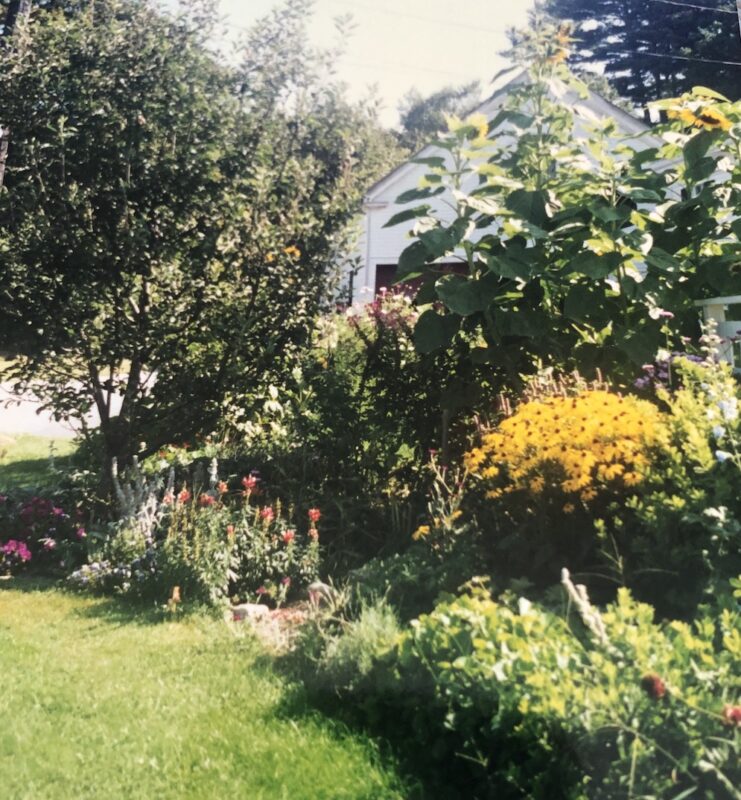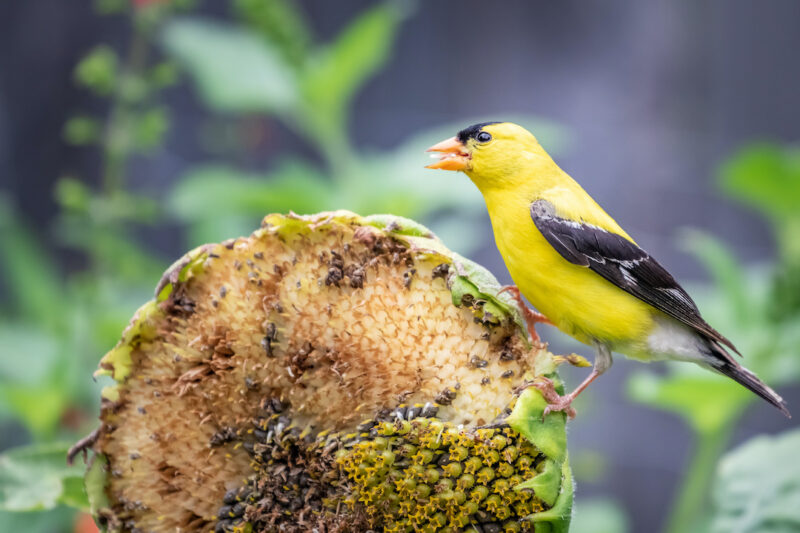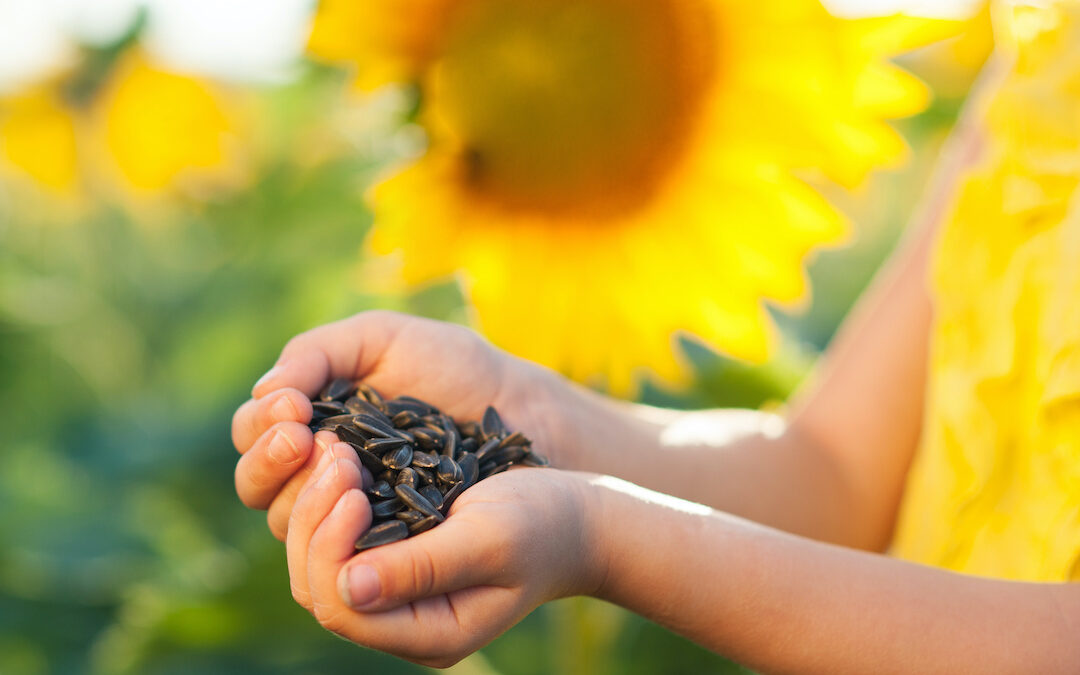When the reality of the world wears on me, I return to the simple joys like planting sunflowers with children to cultivate my own peace — and share it. “Kids love them” tops my list of 10 Reasons to Plant Sunflowers in 2022.
Blooming sunflowers in bright yellow and gold, burning oranges and rich, dark reds with their deep-brown centers fill my garden dreams — especially in these final days of March as high winds whip snow flurries outside my window.
Seeds in pretty paper packets await the coming, warm days in central Pennsylvania.
When the frosts have passed, I’ll plant tall, giant ‘Mammoth’ flowers in the back to grow beside the pile of firewood neatly stacked for next winter. There, when late summer’s heat arrives perhaps those blooming heads can help soothe visitors to the cemetary out behind our house and yard.
Smaller blooms on branched stems in lemon yellow and merlot red — old-fashioned ‘Lemon Queen’ and ‘Velvet Queen’ — will look best beside the rockers and porch swing, near the vegetable beds. And for the new beds on the west side of our house, I’m picturing Tithonia — known by its common name as Mexican sunflower — a variety full of bright orange flowers that attracts butterflies and bees.
The more I learn about sunflowers, the more I love them.
Large Seeds for Small Hands
My affection for sunflowers began with those happy, enchanting colors, then deepened as I began gardening with kids. Large, easy-to-handle seeds for small hands and fast-growing plants make sunflowers a garden favorite for kids.
Sunflowers feed birds and bees. They can heal the soil of toxins and have become a symbol of solidarity with the resilient people of Ukraine. (Read: Soniashnyk, the New Face of Flower Power.)
Until the end of March, the seed company Botanical Interests is donating 100 percent of proceeds from all of its online sunflower seed sales to Sunflower of Peace, a non-profit in Boston that provides resources and life-saving medical supplies to people affected by the crisis in Ukraine and Eastern Europe, caused by Russian President Vladimir Putin’s invasion of Ukraine.
Finding Common Ground in the Garden
Those blooms take me back to planting sunflowers with children in my first big garden, near Winnegance, a soul-nourishing spot on the Maine coast where the tidal Kennebec River meets the border of Bath and Phippsburg.
In my 20s, I’d rented a tiny, two-room, two-story apartment at one end of an old, handsome Greek Revival home of a carpenter and his wife, an artist, and their four children. Together, we designed, tilled and planted a garden in the full sun that was 60 feet long and 10 feet wide. One spring Saturday, Walter — a carpenter and my landlord — wore a broad-brimmed hat to shield the sun and built a long trellis about six feet tall by hand to bisect the garden along except for a tall, handsome arbor in the middle.
We planted vegetables on one side of the trellis and a perennial flower garden on the other. And, oh my, did it grow lush and produce gorgeous flowers and vegetables.
At one end, the garden dog-legged around a peach tree, where we planted sunflowers that soared 10 to 12 feet into the air.
The kids loved planting the sunflowers and watching as the tiny stem first pushed out of the ground and then grew into a thick, towering stalk to support a huge yellow head.

Mend & Strengthen Community
My landlord-neighbors and I did not agree on politics. But wow did we come together over common ground to grow a glorious flower garden and delicious food for all of us in the neighborhood to enjoy.
Ever since, I’ve been hooked on the power of gardening to mend and strengthen the stitching of community — and on the importance of sharing a garden with children. Soon after I moved to Bellefonte, Pennsylvania, a group of volunteer-gardeners and I created a garden for children in the community. There, children have their own garden to explore and nurture their sense of wonder in the natural world.
Thanks to a lot of hard work and passionate people, the garden continues to be a beautiful place for kids to learn cool things about plants and nature.
When concerns and the reality of the world wear me down — I go back to the basics and the simple joys of planting sunflowers with children, my favorite reason to plant sunflowers, as a small action that matters. Let’s remember what kind of world we want our children and grandchildren to live in.
Top 10 Reasons to Plant Sunflowers
1. Kids love sunflowers.
The seeds are big and easy to see and handle for little hands. Sunflowers are easy to grow, grow quickly and reward you with fun, sunny blooms. I’m so looking forward to growing sunflowers with our grandson — not that I want him to grow up that fast!
2. Happy, cheery blooms.
How can you go wrong with that? Did you know: A sunflower bloom is actually a group of more than 1,000 flowers. Ray flowers look like petals and make up the outer ring. Each one is actually a distinct flower. Each tiny flower in the center, inside that outer ring of ray flowers, contains five petals. Look up close at all the tiny flowers the next time you see a sunflower bloom.
3. Sunflowers are Native to North America.
That means the plant naturally occurred in a region, also known as indigenous or endemic, so it is well-suited to growing in that location and benefits the native bees, butterflies and birds. Those native plants have been bred with non-native plants to create new varieties. But the closer you can stick to the native plant, the greater the benefit to wildlife and the healthier your ecosystem.
4. Wide Variety of Colors, Bloom Size and Height
We have so many beautiful options of sunflowers to grow.
Sunflower varieties vary primarily by color, bloom size, height — and how much they benefit wildlife.
One big difference is whether the bloom contains pollen. Allergy issues are a good reason to grow pollen-less blooms. Children or adults may be allergic to pollen or the bees gathering pollen.
A pollen-free sunflower still allows you to enjoy growing pretty flowers.
Since none of my family members or neighbors have allergies or a bee allergy, and I prefer plants that benefit wildlife, I choose sunflowers that contain pollen to benefit pollinating insects like bees and butterflies.
Bees generally are quite busy searching and gathering food, so we just leave each other alone in the garden. No problem — even when I’m up close trying to get a good picture.
I also choose plant varieties as close to the native species as possible, so I’m looking for botanical names.
OK – this gets a little complicated, so bear with me. Think of this in shades of grey, or as “good,” “better” and “best.”
Growing your own flowers or buying from a local flower farm — especially if you share the experience with children — is GOOD, always better than life without flowers (gasp!) or plastic flowers or buying from the grocery store. (Full disclosure: I DO buy grocery store flowers very sparingly, maybe twice in winter, when I’ve just got to have some fresh flowers.)
Growing your own is a wonderful way to connect to nature. Plus, you can avoid toxic chemicals like pesticides and the energy use often involved in global, commercial flower production. (Learn more about this in Amy Stewart’s book.)
BETTER: Pick varieties of sunflowers that help bees and butterflies. One simple rule: Pick varieties that produce pollen. Here’s a great write-up of pollen-rich, heirloom and classic favorites like ‘Lemon Queen,’ ‘Mammoth Russian’ and ‘Velvet Queen.’
My goal is to grow plants that benefit wildlife, so when I’m shopping for seeds and plants, I steer my purchases toward native plants, often searching using botanical names, and shopping at nurseries and seed suppliers that properly label their products.
The BEST for me: When I can grow a healthy, native plant with confidence.
5. Sunflowers (with pollen) are great for pollinators.
Remember: Pollination is essential for a lot of food plants. One-third of our food supply comes from pollinated crops like apples, melons, and almonds. Blueberries and cherries are 90 percent dependent on honey bee pollination.
The four species below — only four of 52 species in the genus Helianthus — are native and attract a tremendous diversity of insects including bees, wasps, flies, butterflies and pollen-eating beetles, according to the Xerces Society, a non-profit organization working to conserve North America’s native pollinators.
This is good! Without healthy pollinators, we risk our food supply.
- The annual, common sunflower Helianthus annuus L., has yellow heads about four inches wide and is one of 52 species in genus Helianthus. This is often a wildflower found on prairies and grasslands, fields, roadsides and the edges of the forest. Learn more here.
- The woodland sunflower, Helianthus divaricatus, a perennial sunflower suited to shady locations in the eastern United States; Learn more here.
- Maximilian sunflower (Helianthus maximiliani) is a tall species suited to dry sunny spots. Learn more here.
- Prairie sunflower, H. petiolaris, is a 3-5 foot annual sunflower with lots of branches and blooms. The outside petals are yellow and the centers are red-purple. Gorgeous! Learn more here.
Plus, there are many more species and among those many varieties that are cultivars or hybrids. A “cultivar” means selective breeding has created a cultivated variety that retains certain desirable characteristics — but may have lost the characteristics important to wildlife. A “hybrid” plant is a new plant created by cross-pollinating two genetically different parent plants.
Seed and plant shopping can get very complicated for some of us!
Remember: To keep it simple, select sunflowers with pollen to be sure your sunflowers feed pollinating insects like honeybees.

6. Sunflowers attract and feed birds.
One of the simplest ways to feed the birds is to leave the dried sunflower heads right on the stalk, or to place them around the garden in spots where the birds have some shelter from predators.
Sunflower seeds attract the widest variety of birds. Black oil sunflower seeds are considered the best all-around for feeding birds. So — naturally, when the flower heads have dried, birds can pick the seed straight from the dried flower heads.
You have many options here! The giants and mammoths, of course. And Tithonia, or Mexican sunflowers, with small orange flowers that attract hummingbirds and butterflies. Check them out.
7. Sunflower seeds are delicious for us, too.
Harvest the smaller seeds and add them to salads, muffins, breads — or just snack on them. My favorite salad: spinach greens, thin-sliced red onions, red grapes, and feta cheese. A combo I first enjoyed at (now-closed) Bluestone Bistro in Cleveland Circle, Boston.
8. Natural Healing.
Studies show that sunflowers can absorb toxic heavy metals and radiation from the soil. Radioisotopes in the soil mimic some of the nutrients the plant normally takes up like potassium and calcium. The plant then stores those toxins in its stems and leaves, where they can be harvested and disposed of — leaving cleaner soil in place.
To help absorb radiation after the Fukushima and Chernobyl nuclear crises, big fields of sunflowers were planted, with mixed results.
Researchers are working to understand which species are best for this and which species resist this.
9. Sunflowers Follow the Sun.
Watch sunflowers throughout the day and you may notice that their blooms follow the sun. At dawn, sunflower plants face east, turn west through the day and return to face east at night.
Why?
Sunflowers use an internal circadian clock and act on growth hormones to follow the sun throughout the day, according to a study conducted and co-authored by plant biologists Stacey Harmer and Benjamin Blackman at the University of California-Davis.
Plants grow faster and larger when they follow the sun, according to the experiments. And, as the sunflowers mature and the bloom opens, it settles into facing east — apparently to be more attractive to pollinators.
In one experiment, researchers grew sunflowers in pots in a field, then turned some to the west. When they compared measurements with an infrared camera, they found the east-facing flowers warmed more quickly in the morning and attracted five times as many pollinating insects.
Bees apparently like warm flowers.
10. A Powerful Symbol of Peace.
Finally, sunflowers have long-symbolized peace and in the last few weeks have come to symbolize solidarity with the people of Ukraine. Ordinary people can do extraordinary things and we all have a role to play in bringing about peace in the world. Read Soniashnyk is the New Face of Flower Power.
~~~
A little while ago, when I refreshed the house decor, I hung a beautiful, gold-framed summer scene of sunflowers growing against the pine green front porch of the Winnegance General Store .
An artist and neighbor from Maine gave me this print of her painting as a gift. Those bright and cheery blooms greet me a few times a day, as I head out to check on the spring weather, sustaining me until I can push my hands and fresh sunflower seeds into the rich, warm soil.


Thanks for all the information on sunflowers! I learned a lot.
You are most welcome, Bev! I’m obsessed with them. Thanks for reading.
Lisa, very good article! Yes, they are beautiful and I enjoyed learning more about them.
Paula